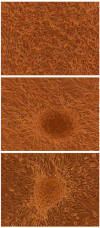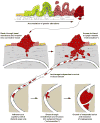In vitro models of pancreatic cancer for translational oncology research
- PMID: 20160967
- PMCID: PMC2760831
- DOI: 10.1517/17460440902821657
In vitro models of pancreatic cancer for translational oncology research
Abstract
BACKGROUND: Pancreatic cancer is a disease of near uniform fatality and the overwhelming majority of patients succumb to their advanced malignancy within a few months of diagnosis. Despite considerable advances in our understanding of molecular mechanisms underlying pancreatic carcinogenesis, this knowledge has not yet been fully translated into clinically available treatment strategies that yield significant improvements in disease free or overall survival. OBJECTIVE: Cell line-based in vitro model systems provide powerful tools to identify potential molecular targets for therapeutic intervention as well as for initial pre-clinical evaluation of novel drug candidates. Here we provide a brief overview of recent literature on cell line-based model systems of pancreatic cancer and their application in the search for novel therapeutics against this vicious disease. CONCLUSION: While in vitro models of pancreatic cancer are of tremendous value for genetic studies and initial functional screenings in drug discovery, they carry several imanent drawbacks and are often poor in predicting therapeutic response in humans. Therefore, in most instances they are successfully exploited to generate hypothesis and identify molecular targets for novel therapeutics, which are subsequently subject to further in-depth characterization using more advanced in vivo model systems and clinical trials.
Figures


Similar articles
-
Recent developments of transgenic and xenograft mouse models of pancreatic cancer for translational research.Expert Opin Drug Discov. 2011 Jan;6(1):33-48. doi: 10.1517/17460441.2011.534453. Epub 2010 Nov 19. Expert Opin Drug Discov. 2011. PMID: 22646825
-
SCNrank: spectral clustering for network-based ranking to reveal potential drug targets and its application in pancreatic ductal adenocarcinoma.BMC Med Genomics. 2020 Apr 3;13(Suppl 5):50. doi: 10.1186/s12920-020-0681-6. BMC Med Genomics. 2020. PMID: 32241274 Free PMC article.
-
Folic acid supplementation and malaria susceptibility and severity among people taking antifolate antimalarial drugs in endemic areas.Cochrane Database Syst Rev. 2022 Feb 1;2(2022):CD014217. doi: 10.1002/14651858.CD014217. Cochrane Database Syst Rev. 2022. PMID: 36321557 Free PMC article.
-
Dietary glycation compounds - implications for human health.Crit Rev Toxicol. 2024 Sep;54(8):485-617. doi: 10.1080/10408444.2024.2362985. Epub 2024 Aug 16. Crit Rev Toxicol. 2024. PMID: 39150724
-
Translational Metabolomics of Head Injury: Exploring Dysfunctional Cerebral Metabolism with Ex Vivo NMR Spectroscopy-Based Metabolite Quantification.In: Kobeissy FH, editor. Brain Neurotrauma: Molecular, Neuropsychological, and Rehabilitation Aspects. Boca Raton (FL): CRC Press/Taylor & Francis; 2015. Chapter 25. In: Kobeissy FH, editor. Brain Neurotrauma: Molecular, Neuropsychological, and Rehabilitation Aspects. Boca Raton (FL): CRC Press/Taylor & Francis; 2015. Chapter 25. PMID: 26269925 Free Books & Documents. Review.
Cited by
-
Patient-Derived Xenograft Models of Pancreatic Cancer: Overview and Comparison with Other Types of Models.Cancers (Basel). 2020 May 22;12(5):1327. doi: 10.3390/cancers12051327. Cancers (Basel). 2020. PMID: 32456018 Free PMC article. Review.
-
Establishment and characterization of a novel ovarian high-grade serous carcinoma cell line-IPO43.Cancer Cell Int. 2022 Apr 30;22(1):175. doi: 10.1186/s12935-022-02600-3. Cancer Cell Int. 2022. PMID: 35501869 Free PMC article.
-
Ascites-derived pancreatic ductal adenocarcinoma primary cell cultures as a platform for personalised medicine.Br J Cancer. 2014 Apr 29;110(9):2269-76. doi: 10.1038/bjc.2014.123. Epub 2014 Mar 25. Br J Cancer. 2014. PMID: 24667644 Free PMC article.
-
Beyond just a tight fortress: contribution of stroma to epithelial-mesenchymal transition in pancreatic cancer.Signal Transduct Target Ther. 2020 Oct 30;5(1):249. doi: 10.1038/s41392-020-00341-1. Signal Transduct Target Ther. 2020. PMID: 33122631 Free PMC article. Review.
-
Identification of the Serine Biosynthesis Pathway as a Critical Component of BRAF Inhibitor Resistance of Melanoma, Pancreatic, and Non-Small Cell Lung Cancer Cells.Mol Cancer Ther. 2017 Aug;16(8):1596-1609. doi: 10.1158/1535-7163.MCT-16-0798. Epub 2017 May 12. Mol Cancer Ther. 2017. PMID: 28500236 Free PMC article.
References
-
- Jemal A, Siegel R, Ward E, Hao Y, Xu J, Murray T, et al. Cancer statistics, 2008. CA Cancer J Clin. 2008 Mar–Apr;58(2):71–96. - PubMed
-
- ACS. Cancer Facts & Figures 2008. Atlanta: American Cancer Society; 2008.
-
- Jamieson JD. Prospectives for cell and organ culture systems in the study of pancreatic carcinoma. J Surg Oncol. 1975;7(2):139–41. - PubMed
-
- Longnecker DS, Wiebkin P, Schaeffer BK, Roebuck BD. Experimental carcinogenesis in the pancreas. Int Rev Exp Pathol. 1984;26:177–229. - PubMed
Grants and funding
LinkOut - more resources
Full Text Sources
Other Literature Sources
